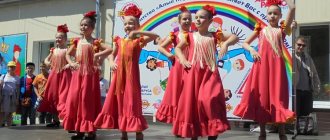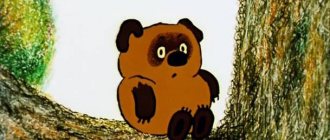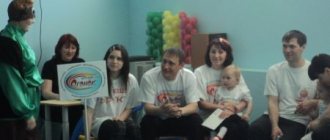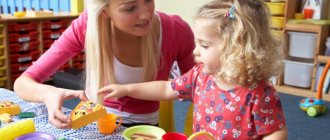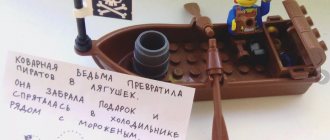Cultural practice “Literary living room”
Cultural practice
"Literary Lounge"
senior group "Sun"
Art. teacher Litvinova N.V.,
teachers: Kozlova A.Yu., Shikina I.A.
“Children’s books are written for education, and education is a great thing.” V.G. Belinsky
The life of a modern person is very dynamic, and progress, which makes life easier in many ways, sometimes deprives us of the most important thing - the need to think, analyze, reflect, fantasize and create. It is very important for modern children to learn in early childhood to be creators and inventors, not to use a ready-made solution, but to look for a new unexplored path!
This requires special cultural practices
child, providing active and productive educational activities. These are various types of independent activity, behavior and experience based on the child’s interests, methods of self-determination and self-realization, testing of new methods and forms of activity in order to satisfy various needs and interests. Cultural practices in preschool educational institutions are based on the interaction of a child with adults.
During preschool childhood, one of the tasks of educational activities is to familiarize children with fiction and its various genres.
From early childhood, a love for the artistic word is laid. Literature expands ideas about the environment, develops the ability to subtly sense the artistic form, melody and rhythm of the native language.
Over the past decades, a negative trend has emerged: a significant decline in reading books in general and fiction in particular.
Firstly, global informatization of the objective space surrounding every person: through the Internet, both children and adults can freely and without much difficulty obtain any data on any topic, including a “compressed” version of any literary work.
Secondly, dominance in the media (television, press)
advertising that forms a child’s idea of pseudo-values in a person’s life. Children know a lot about consumer electronics, cars, cell phones.
Thirdly, objective economic and financial difficulties lead to the fact that adults are forced to devote all their thoughts and time to earning material wealth. They don't even remember books! Psychologists have proven that it is parents who are role models for children. If parents don't read, they can't expect their children to.
The child begins to get acquainted with literature at an early age. At first, he is interested in turning the pages, listening to an adult read, and looking at the illustrations. With the advent of interest in the picture, interest in the text begins to arise. One of the features of children’s perception of a literary work is empathy for the characters. Perception is extremely active. The child puts himself in the place of the hero, mentally acts, fights his enemies.
“In the land of cheerful childhood” Literary lounge for children and parents
Problem: How, based on familiarity with creativity, to form a sustainable interest in reading as a source of meaningful and entertaining family leisure time, to expand the social partnership of children and parents on the basis of joint creative activity.
Project: Literary-educational, creative, implementation period - 2 months.
Project participants: Children of the preparatory group, families of pupils, kindergarten teachers.
Tasks:
- Continue to introduce children to life and creativity. To form a sustainable interest in literature and reading poetry. To develop the creative abilities of preschoolers in the process of joint activities with parents. Continue to improve the artistic and speech performance skills of children when reading poetry, in dramatizations (emotionality, expressiveness of performance). To develop in children creative abilities, the ability to create expressive images of heroes of literary works, using various visual techniques (pantomime, intonational expressiveness of speech).
Preliminary work with children:
- Reading works, looking at illustrations. "Excursion" to the workshop of illustrators. Watching cartoons based on works of the same name.
- Drawing based on the works of the author “My favorite literary hero Agnia Barto.” Solving crossword puzzles based on the author's works. Making invitation cards. Making multimedia games for students based on the poet’s work. Learning poems by A. Barto. Watching the film "Foundling". Learning songs to the words of A. Barto “Amateur Fisherman” (music by M. Starokodamsky) and “Polite Waltz” (music by D. Kabalevsky).
Preliminary work with parents:
- Consultation for parents “The path to the land of books by A. Barto. From listener to reader."
- Workshop “Development of creative abilities in children through various visual techniques (pantomime, intonation expressiveness of speech).”
- Master class “Solving a crossword puzzle with preschoolers.” Master class “Presentation as a result of the project work.”
Equipment:
Layout of a large book with the title “Country of Cheerful Childhood”, children’s drawings depicting the heroes of poems, a portrait of A. Barto, a crossword puzzle, a presentation about the biography, a multimedia projector, an interactive board, multimedia games based on the works, phonograms of the songs “Amateur Fisherman” (lyrics by A. Barto, music by M. Starokodamsky) and “Polite Waltz” (music by D. Kabalevsky), costumes for performances.
Literary lounge “In the land of cheerful childhood.”
To the soundtrack of the song “Amateur Fisherman” (lyrics by A. Barto, music.
M. Starokodamsky) children and parents enter the hall and sit down at the tables. The hall is decorated with multi-colored balls and toys, a large closed book, on the pages of which a portrait, children's drawings based on the author's poems, and pages with an image of a treble clef are hidden from the viewer's eyes.
Leading:
- Guys, dear guests!
I invite you to our “Literary Living Room”. Our meeting today is dedicated to the famous children's poet. What kind of poet is this? Try to guess for yourself!
Poems are different:
Nice, simple,
Poems are sad
There are also funny ones.
This poet is one of the most famous and beloved children's poets, whose poems are familiar not only to you, but also to your mothers and fathers, and even grandparents. The poet devoted all his work to children, their upbringing and problems.
- Did you guess? No? I suggest you solve a crossword puzzle in which the name of the poet is hidden.
Solving a crossword puzzle (Appendix).
The book in front of you is a journey to the Land of cheerful childhood. Open it and you will immediately find yourself in this wonderful country. There is something interesting for everyone here, everyone will find something to smile about.
The presenter approaches the book, opens the first page and
shows a portrait of A. Barto.
Leading:
- Guys, look, we have a portrait of the famous children's poetess Agnia Barto, who wrote many poems for children. If someone does not know the poems of Agnia Barto, it means that he was not born in our country. Having barely learned to speak, every Russian child gets acquainted with the story of a bull that is about to fall, of a bunny abandoned by its owner, and of Tanya dropping a ball into the river. Then, as an adult, he reads these poems with no less interest, first to his children and then to his grandchildren. These lines run like a thin, barely noticeable thread through our lives, tightly connecting different generations and leaving a bright trace of childhood memory in our souls.
Today we will go on a journey to the land of poems written by the children's poetess Agnia Lvovna Barto.
Let's begin our journey by getting to know the life story of Agnia Barto. Our family will help us with this...
A presentation with a story is being shown (Appendix).
Take a closer look at this kind face of a woman whose creative motto was the words: “I gave children joy, and the children returned my youth to me.” Even at 75 years old!” This is a famous children's writer, whose poems every child in our country knows. There are books that all kids love. Among these books are poems by Agnia Barto.
Agnia Lvovovna was born in Moscow on February 17, 1906. There she studied and grew up. Her father, Lev Nikolaevich Volov, was a veterinarian, and they always had many different animals in the house. Agnia studied at the gymnasium. She started writing poetry in elementary school. She dreamed of becoming a ballerina, graduated from a choreographic school, but did not discover much talent in this activity.
Agnia Barto published her first book, “The Chinese Little Wang Li,” when she was nineteen years old. After the publication of the book for little ones “Toys” (1936), as well as the poems “Flashlight”, “Mashenka” and others, Barto became one of the most famous and beloved children's poets by readers. The images and plots of her poems turned out to be close and understandable to children.
A. Barto could often be seen among the guys. She visited schools, attended classes, and met her readers in children's libraries.
She wrote not only about children, she has many books about animals. These are the books “Who Screams,” “Little Frogs,” “Uti-Uti,” “Little Bear is an Ignorant” and many others. But all her poems are very interesting, rhythmic, and easy to remember.
Many cartoons were created based on the poems of Agnia Barto. Of course you remember them! This … . Many of Agnia Barto's poems became songs. Who can name them?
A. Barto also wrote scripts for feature films. “Alyosha Ptitsyn develops character”, “Ten Thousand Boys”, “Elephant and String”.
But there is one film that everyone knows: from young to old. This film is about a girl who gets lost. Remember what it's called? That's right, this is the film "Foundling" and we watched it.
During the Great Patriotic War, Agnia Lvovna lived in Sverdlovsk, published war poems and articles. As a correspondent for Komsomolskaya Pravda, she visited the Western Front in 1942. But during the war and after it, A. Barto continued to write about children and for children. This is how a new book of poems appeared, “Zvenigorod” (1947) - a book about children from orphanages, that is, children who lost their parents during wartime, and about the people who care about them.
It so happened that this book fell into the hands of a woman whose 8-year-old daughter Nina was lost during the war. The mother considered her dead, but after reading the poem, she began to hope that her daughter was alive and that someone had taken care of her all these years. Agnia Lvovna handed over this letter to a special organization where people worked searching for missing people. After 8 months, Nina was found. A newspaper article was published about this incident. And then Agnia Lvovna began to receive letters from different people: “Help me find my son, daughter, mother!” To help such people, A. Barto began broadcasting the “Find a Person” program on the radio. Over the course of 9 years, 927 families were reunited. In 1969, the poet wrote the book “Find a Person,” which told the stories of people who had lost and found each other.
I have been to many countries around the world and met children everywhere. She did a lot to ensure that children from different countries were friends. Agnia Barto left behind one and a half million books in 86 languages from different countries of the world, wonderful poems that many people know and remember. For her work she was awarded high state awards.
Agnia Lvovna Barto was known and loved not only in our country. She has been awarded several international prizes and medals, recognizing famous people who bring joy to children and who have made the most significant contribution to the cause of childhood protection. In addition, one of the small planets that revolve around the Earth is named after her.
In our country there is a museum of Agnia Barto. It appeared thanks to the close cooperation of Library No. 99, which bears the name of the poetess, with her daughter, Tatyana Andreevna Shcheglyaeva, and is located in Moscow.
But the most important memory of the wonderful children's poet is her books, her poems. These books were read by your grandparents. These books were read by your mothers and fathers. The books were republished at different times: covers and illustrations changed, but one thing remained unchanged - the interest of children in the author’s poems.
The presenter thanks the family... and goes to the book and opens the next page, on which are children's drawings depicting heroes of A. Barto's poems.
Leading:
- Look who it is?
(Children call the heroes of the poems Lida (“Rope”), Tanya and Tamara (“Tamara and I…”), Andryushka (“Rattle”), Vovka (“Vovka the good soul”), Lyubochka (“Lyubochka”), Tanya ( "Assistant")).
Leading:
Well done! How many poems do you know? Can you read them like real artists? I propose to hold a reading competition. The audience will evaluate the performances with applause.
Leading:
And now the family is taking part in the reading competition... . They have prepared a dramatization of the poem for you. Look carefully and guess its name.
Dramatization of the poem “The Herd Game.”
Leading:
— Did you recognize the heroes of the work? What is it called? But someone else came to visit us!
Two girls appear (a roaring girl and a grimy girl)
Roaring Girl:
- We have prepared two riddles for you - pantomimes. Guess which poems we are the heroes of?
Pantomime show. Children's answers.
Leading:
- Thanks to the family..., who prepared these interesting pantomime riddles for us.
The presenter opens the next page.
— Guys, look at this interesting sign. What does it mean in our literary living rooms? Right! Musical pause. What kind of musical break awaits us today?
A child appears with a fishing rod and bucket, offers to guess which poem he is the hero of, and to sing the song “An Amateur Fisherman” with him.
Leading:
- Attention! Attention! A literary quiz is being announced for connoisseurs of Agnia Barto’s work! I propose to invite our artists to the jury of the competition. The teams are divided according to the color of the circle that you chose before the start of the literary lounge (you get joint teams of students and their parents).
1. Auction. It is necessary to determine the fairy tale based on its briefly formulated content (on the interactive board, the correct answer is determined by the arrow that appears). (Application )
2. “Give me a word” You need to finish the text being read and name which poem this passage is from (on the interactive board, the correct answer is determined by the book that appears). (Application )
3. “Literary crossword.”
Leading:
— The next stage of our literary quiz will be a literary crossword puzzle. It was compiled and presented to you today by the family...
Guessing a crossword puzzle (Appendix).
Leading:
- Well done, you completed the crossword puzzle quickly. Let's give a round of applause to its authors.
The jury sums up the results of the literary quiz.
Leading:
“I am very pleased to note that you, dear guests of our literary drawing room, know the poems of Agnia Lvovna Barto very well, are inquisitive and quick-witted. This means that you are not in danger of mental idleness. And as a reward for your knowledge and intelligence, the family... has prepared a musical surprise for you.
The song “Polite Waltz” is performed (lyrics by A. Barto, music by D. Kabalevsky).
Leading:
— Our journey through the book “Land of Cheerful Childhood” has come to an end, where we were again able to meet the work of the wonderful author of children’s books, Agnia Lvovna Barto. And I would like to end our holiday with the words of the no less famous children's poet Sergei Mikhalkov, who wrote about Agnia Barto:
“Ask any five-year-old person who also doesn’t know how to hold a book in his hands: “Should I read Barto to you?” - and he nods his head. Barto - this means clear, funny and interesting poems to him. This means he will hear about guys like himself or older. And she will hear the pure truth, because the poetess knows very well all the children’s pranks, little tricks, and knows how to cheerfully talk about everything, and can joke cheerfully.”
Get text
Literary lounge in the middle group “The World of Fairy Tales by K. I. Chukovsky” with the participation of parents
Sazykina Svetlana Nikolaevna
Literary lounge in the middle group “The World of Fairy Tales by K. I. Chukovsky” with the participation of parents
Literary lounge in MDOBU “Kudrovsky DSKV No. 1 middle group No. 6 on the topic :
"The world
of fairy tales K. I. Chukovsky " (with
the participation of parents ) A. N. Logutenkova
Integration of educational areas: “Speech development”
,
“Social and communicative development”
Goals: To introduce children to the culture of reading children's fiction . To consolidate and systematize children's knowledge about the works of K. I. Chukovsky .
To consolidate children's knowledge about previously read works by K. I. Chukovsky .
Develop observation, creative imagination and imagination, attention and memory.
Learn to distinguish and convey the mood and emotional states of characters.
Preliminary work: Reading fairy tales by K. I. Chukovsky , viewing illustrations, watching cartoons, conversations on the material read and viewed, exhibition of drawings based on the works of K. I. Chukovsky ( parents and children )
.
